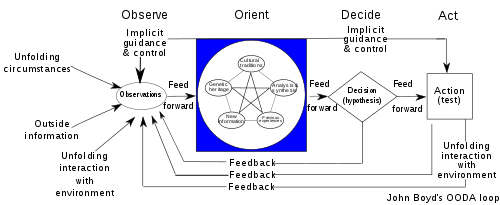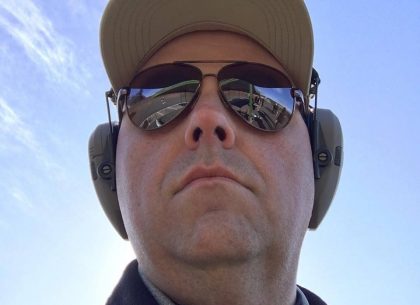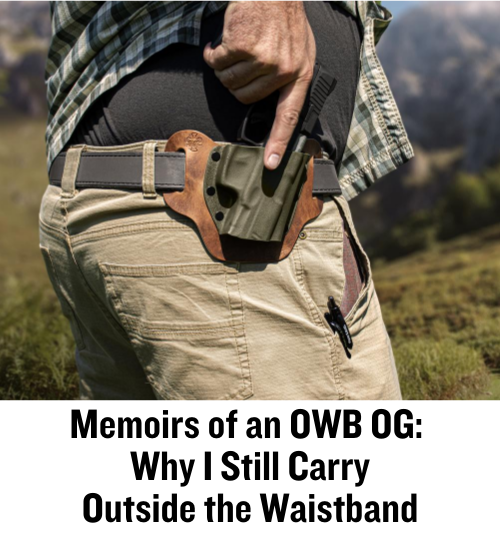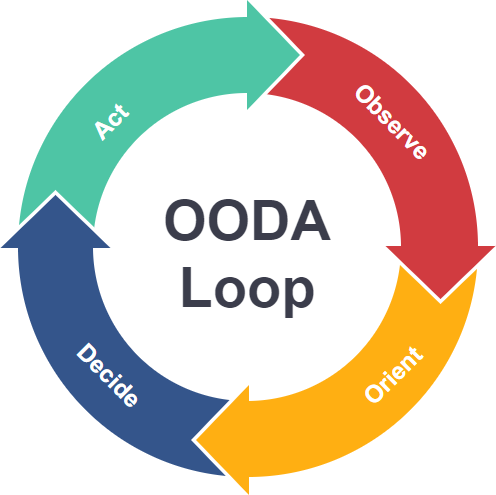The four steps of OODA play out every time we take an action.
![]()
![]()
Whether or not you’ve heard of the OODA Loop, you use it every day without knowing it. It’s not a mechanical device, nor is it some weird time-space sci-fi phenomenon. But it is scientific.
The OODA Loop is the decision and reaction process we go through every time an outside influence stimulates our minds. It doesn’t just apply to personal defense, but that is how we will look at it here.
The concept of OODA was pioneered by military strategist and United States Air Force Colonel John Boyd, who applied it to military strategy and how soldiers reacted to stimulus on the battlefield. Over the years, the concept naturally trickled down to many areas of life, including self-defense.
Like so many military-based concepts, OODA is an acronym, in this case standing for Observe, Orient, Decide, and Act. So let’s break them down step by step and see how they all fit together.
You stop at the local convenience store perusing the snack aisle during a brief stop on your road trip when you hear a man shout “Open the register!” to your left. This is where the OODA loop kicks in.

Observe
Our immediate natural reaction in any situation is to observe our surroundings and figure out what is happening to respond. Something caused us to stop what we were doing. What was it?
In this case, it was the man shouting. That’s not normal. It was out of place. Chances are, your head snapped in his direction because it startled you. This is the Observation phase. Here you begin to take in the surroundings with a heightened sense of awareness. You see the shouting man. You see where he is standing near the register. You see he is pointing a gun at the clerk.
Orient
Now that you’ve been alerted to the situation through observation, the next natural reaction is to Orient yourself toward what you observed. This doesn’t mean you’re ready to take action. That’s coming up, but you’re not there yet.
Your body will reflexively begin to turn toward what you observed as you prepare for the next step.
Decide
Up until now, you have reacted in a semi-passive way to the situation. First, you observed what was happening and then began to orient yourself toward the stimulus. Notice I did not say “toward the threat” because you have not decided if what you’re observing is a threat. That comes now.
Now is when you decide what you’re going to do with the situation in front of you. Do you need to take action? If so, what action? Your decision will be based on several factors, including but not limited to:
- Are you equipped to take action?
- What sort of reaction is necessary?
- How fast can you execute whatever action you choose?
- Who else is around you?
- What obstacles are in your way?
- What will happen if you act?
- What happens if you don’t act?
These are all important considerations as you decide your next steps. For example, do you engage what you now see as a bad guy presenting an armed threat to the clerk? Do you stand fast because there are too many innocent bystanders who might be at risk if you engage? Are you at a tactical advantage or disadvantage in your current position?
“Decide” is often the longest step in the OODA Loop because you are adding Observe back into the equation as you decide what can, cannot, should, and should not do in response to the situation.
Act
You’ve made your decision. In this case, you decided your best option was to engage the bad guy because you are equipped, and the situation looks favorable toward a good outcome with the course of action you decided upon. The proverbial moment of truth has arrived.
Taking action is the public part of the OODA Loop. Everyone now knows what you decided because you are acting on that decision.
Prepare
Your actions will affect everyone involved. One way to ensure you are taking the right action is to already have a plan in place in case of situations like this. Roleplay it ahead of time. Think through what you might do beforehand. Practice it in your head and at the range. Discuss it with your family since they might be with you. Although there is no P in OODA, Preparation is a key component. Practice the OODA Loop every day. Think about situations you’re in where something out of the ordinary happens and you react. Most of the time, your reaction will be to shrug it off and go about your life because it was no big deal. That loud banging sound was a book falling off the shelf or a minor fender bender that the two parties resolved peacefully. But you reacted with an OODA Loop each time because it happens all the time.
ABOUT THE AUTHOR:

David Workman is an avid gun guy and a contributing writer to several major gun publications. As an NRA-certified instructor, David trains new shooters on basic handgun skills and CCW requirements and is a strong advocate for training as much as possible. “Real-life shootouts don’t happen at a box range.”
![]() You may also enjoy these popular articles:
You may also enjoy these popular articles:




©MTC Holsters, LLC and CrossBreed Holsters Blog, 2021.
Unauthorized use and/or duplication of this material without express and written permission from this site’s author and/or owner is strictly prohibited. Excerpts and links may be used, provided that full and clear credit is given to David Workman and the CrossBreed Blog with appropriate and specific direction to the original content.
![]()





